Papers by Dr. subhash kamal
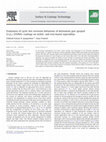
Surface and Coatings Technology, 2009
Cr 3 C 2-NiCr coating Detonation gun Microstructural characterizations In the present investigati... more Cr 3 C 2-NiCr coating Detonation gun Microstructural characterizations In the present investigation, Cr 3 C 2-NiCr cermet coatings were deposited on two Ni-based superalloys, namely superni 75, superni 718 and one Fe-based superalloy superfer 800H by detonation-gun thermal spray process. The cyclic hot-corrosion studies were conducted on uncoated as well as D-gun coated superalloys in the presence of mixture of 75 wt.% Na 2 SO 4 + 25 wt.% K 2 SO 4 film at 900°C for 100 cycles. Thermogravimetric technique was used to establish the kinetics of hot corrosion of uncoated and coated superalloys. X-ray diffraction, FE-SEM/EDAX and X-ray mapping techniques were used to analyze the corrosion products for rendering an insight into the corrosion mechanisms. It was observed that Cr 3 C 2-NiCr-coated superalloys showed better hot-corrosion resistance than the uncoated superalloys in the presence of 75 wt.% Na 2 SO 4 + 25 wt.% K 2 SO 4 film as a result of the formation of continuous and protective oxides of chromium, nickel and their spinel, as evident from the XRD analysis.

MATEC Web of Conferences, 2018
One of the common ways to overcome wear is by surface modification which is a coating process. Th... more One of the common ways to overcome wear is by surface modification which is a coating process. The application of cermet of chromium (Cr carbide) in Nickel-Chromium (Ni-Cr) matrix is widely used as coating material since it provides high wear resistant. Besides, thermal spray process is widely known as the most suitable technique to produce cermet coating. In this study, chromium carbide-nickel chrome (Cr3C2-NiCr) powder is used as the feedstock. High Velocity Oxy Fuel (HVOF) thermal spraying is used to deposit the coating on mild steel substrate to study the behaviour of wear of the coating. The wear test is conducted by using TABER Linear Abrasion Wear Test machine. The wear rate of both coated and uncoated pin is measured by measuring the weight loss of the samples. The Cr3C2-NiCr coated pins have shown less weight loss than the uncoated pins. The lifetime prediction of Cr3C2-NiCr coated pins is higher than the uncoated pins at different time duration and applied loads. The results showed that the wear resistant properties of Cr3C2-NiCr coated pins are higher than the uncoated pins. Scanning Electron Microscopic (SEM) integrated with Energy-dispersive X-ray spectroscopy (EDS) are used to determine the microstructure of Cr3C2-NiCr coating. The microstructure of Cr3C2-NiCr coated pin after the wear testing showed no presence of crack and the wear track was homogenous.
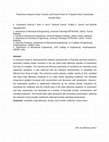
The Canadian Journal of Chemical Engineering, 2016
A numerical model for determining the turbulent characteristics of fluid flow and heat transfer i... more A numerical model for determining the turbulent characteristics of fluid flow and heat transfer is presented, treating certain constants in the van Driest eddy diffusivity equation of momentum and heat as variables. The viscosity and thermal conductivity of nanofluids are estimated using regression equations. It was observed that the turbulent characteristics of nanofluids are different from those of water. The numerical results indicate a higher velocity of SiO2 nanofluid and lower eddy diffusivity compared to Cu under similar operating conditions. The nanofluid temperature gradient increases with concentration and decreases with temperature. However, the temperature gradient is significantly influenced by the particle density. Equations for estimating the coefficient and the Prandtl index in the eddy diffusivity equations of momentum and heat, respectively, are developed as a function of Reynolds number, concentration, and nanofluid properties. The Prandtl index value decreases with increasing concentration, reflecting the reduction in heat transfer coefficients observed at lower operating temperatures.
Abstract. Hot corrosion behaviour of the bare and D-gun coated superfer 800H exposed to low tempe... more Abstract. Hot corrosion behaviour of the bare and D-gun coated superfer 800H exposed to low temperature super-heater zone of the coal fired boiler of Guru Nanak Dev Thermal Power Plant, Bathinda, Punjab, India. The specimens were hanged in the platen super-heater of coal fired boiler where the gas temperature was around 900 oC 10 oC. Hot corrosion experiments were performed for 10 cycles, each cycle consisting of 100 hours exposure followed by 1 hour cooling at ambient temperature. Weight change measurements were done at the end of each cycle. The weight change data used for predicting hot corrosion behaviour of the coated alloys after the total exposure of 1000 hours. The different phases and their distribution in the hot corroded specimens were analysed with the help of FE-SEM/EDS and X-ray mapping. 1
In this paper, a study on the welding parameters for pipeline is done by application of Metal Ine... more In this paper, a study on the welding parameters for pipeline is done by application of Metal Inert Gas (MIG) welding by taking into account welding speed and wire feed rate as the parameters. These parameters are important to determine the tensile strength and weld bead penetration of the welded specimen. Large data sets are necessary to train the Neural Network using Matlab ANN tool and hence enable to predict the desired output. The predicted output is validated by comparing with experimental data.

Engineering Applications of Nanotechnology, 2017
Hot corrosion arises when metals are excited in the temperature range 700–900 °C in the existence... more Hot corrosion arises when metals are excited in the temperature range 700–900 °C in the existence of sulphate deposits, formed as a result of the reaction among sodium chloride and sulphur mixtures in the gas phase adjoining the metals. No alloy is resistant to hot corrosion occurrence indefinitely even though there are certain alloys that require a prolonged origination time at which the hot corrosion progression from the beginning stage to the circulation stage. Superalloys have been established for high-temperature applications. However, these alloys are not constantly able to meet both the high-temperature strength and high-temperature corrosion resistance simultaneously, so the need is to protect from hot corrosion. The high-temperature guarding system must meet numerous benchmarks, provide satisfactory environment resistance, be chemically and mechanically compatible with the substrate, be practically applicable, reliable and economically viable. This chapter briefly reviews the hot corrosion of some Ni- and Fe-base superalloys to recognise the occurrence. Extensive reviews on the hot corrosion of coatings have looked regularly since early 1970; the purpose of this chapter is not to repeat the published resources but relatively to emphasis on research developments and to point out some research forecasts.

Hot corrosion is one of the serious problems in the turbine engines used for aircraft and thermal... more Hot corrosion is one of the serious problems in the turbine engines used for aircraft and thermal power plant applications. Nickel based superalloys form the key structural components of the turbine engines due to its superior strength and high temperature creep properties. However, they do not show an adequate stability against hot corrosion in the high temperature corrosive environments. Therefore, it requires protective coatings, which could impart hot corrosion resistance in the deleterious high temperature environments. Detonation gun sprayed coatings exhibit desirable microstructural morphologies with higher adhesive strength, low porosity and less compressive residual stresses as compared to other thermal spray processes as evident from the literature. The present work has been focused to develop Cr 3 C 2-NiCr coating on the superalloy substrate by Detonation gun spray technique and measure its hot corrosion behavior in the molten salt environment (75wt.%Na 2 SO 4 + 25wt.%K 2 SO 4) at 900 0 C under cyclic conditions for 100 hrs. Thermogravimetry technique was used to measure the kinetics of corrosion of coated and bare superalloy substrates. XRD, SEM and FE-SEM/EDAX were used to characterize the corrosion products. It was found that Cr 3 C 2-NiCr coating served as an effective solid-state diffusion barrier between oxygen (or other gaseous) and the base superalloy substrates. The hot corrosion resistance of the Cr 3 C 2-NiCr coating was due to the formation of protective scales such as oxides and spinels of Ni and Cr.
Applied Mechanics and Materials, 2016
An addition of cerium oxide to NiCrAiY coatings could boost the high temperature properties of th... more An addition of cerium oxide to NiCrAiY coatings could boost the high temperature properties of the coatings in the actual service condition due to the purification of its microstructures. High temperature oxidation studies of D-Gun sprayed MCrAlY coatings with minor addition of CeO2 is inadequate in the literature. Therefore, the present work was focused to study the effect of cerium oxide on the high temperature oxidation behavior coatings on superalloys. Cyclic oxidation tests were carried out for 100 cycles at 900 °C to study the oxidation kinetics of un-coated and bare superalloys. The corroded products obtained during cyclic oxidation of coatings were subjected to XRD, FE-SEM/EDAX and X-ray mapping analysis to reveal the high temperature oxidation mechanisms.

Journal of Materials Research, 2015
Coal is an attractive fuel owing to its low price linked to its worldwide availability but combus... more Coal is an attractive fuel owing to its low price linked to its worldwide availability but combustion of coal generates very corrosive media especially near the superheater tubes. The present investigation is an attempt to evaluate the hot corrosion behavior of detonation-gun sprayed coatings of Cr 3 C 2 –NiCr, NiCrAlY + 0.4 wt% CeO 2 , and NiCoCrAlYTa on superfer 800H, exposed to low temperature super-heater zone of the coal-fired boiler. The specimens were hanged in the platen super-heater of coal-fired boiler where the gas temperature was around 900 °C ± 10 °C. Hot corrosion experiments were performed for 10 cycles, each cycle consisting of 100 h exposure followed by 1 h cooling at ambient temperature. All three coatings deposited on superfer 800H imparted better hot corrosion resistance than the bare uncoated one. The Cr 3 C 2 –NiCr coated superalloy performed better than the other two coatings in the given boiler environment.

The solar flat plate collector operating under different convective modes have low efficiency for... more The solar flat plate collector operating under different convective modes have low efficiency for energy conversion. The energy absorbed by the working fluid in the collector system and its heat transfer characteristics vary with solar insolation and mass flow rate. The performance of the system is improved by reducing the losses from the collector. Various passive methods have been devised to aid energy absorption by the working fluid. Also, working fluids are modified using nanoparticles to improve the thermal properties of the fluid. In the present work, simulation, and experimental studies are undertaken for pipe flow at constant heat flux boundary condition in the mixed convection mode. The working fluid at low Reynolds number in the mixed laminar flow range is undertaken with water in thermosyphon mode for different inclination angles of the tube. Local and average coefficients are determined experimentally and compared with theoretical values for water based Al2O3 nanofluids....
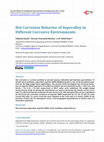
Journal of Minerals and Materials Characterization and Engineering, 2015
Hot corrosion is a serious problem in aircraft, marine, industrial and land-base gas turbines. To... more Hot corrosion is a serious problem in aircraft, marine, industrial and land-base gas turbines. To obviate these problems, superalloy superfer 800H (Midhani grade) is one of the prominent materials for the high temperature applications. The present work investigates hot corrosion behaviour of superfer 800H exposed to two different molten salt environments Na2SO4 + 60% V2O5 and Na2SO4 + 5% V2O5 + 5% NaCl respectively, at 900˚C under cyclic conditions. The weight change measurements made on during the experiments are used to determine the kinetics of hot corrosion. It is observed that the formation of scale rich in Cr2O3, NiO and spinel NiCr2O4 has contributed for the better hot corrosion resistance of superfer 800H. Inspection for 10, 20, 35 and 50 cycles reveals that after 10 cycles Crack has been initiated in the scale and it is clearly visible in the presence of NaCl salt. On subsequent cycles, crack propagates perpendicular to surface and as it encounters inclusions.
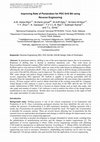
Applied Mechanics and Materials, 2014
In petroleum industry, drilling is one of the most important aspects due to its economics. Reduct... more In petroleum industry, drilling is one of the most important aspects due to its economics. Reduction in drilling time is desired to minimize operations cost. This work focus on Polycrystalline Diamond Compact (PDC) drill bit which is categorized as a fixed cutter drilling bit. Problem such as wear and tear of PDC cutter are some of the main factors in drilling process failure affecting the rate of penetration (RoP). Thus, an intensive study in drill bit design could potentially save costs if the drill bit efficiency can be improved. The objective of this research is to improve the PDC cutter design and analyse design improvement in relation to the rate of penetration using reverse engineering (RE) approach. RE method is capable of resolving unavailable drill bit blueprint from the manufacturer due to propriety and confidential. RE non-contact data acquisition device, 3D laser scanner will be used to obtain cloud data of the existing worn drill bit. Computer Aided Design (CAD) softwa...
MATEC Web of Conferences, 2014
Hot corrosion behaviour of the bare and D-gun coated superfer 800H exposed to low temperature sup... more Hot corrosion behaviour of the bare and D-gun coated superfer 800H exposed to low temperature super-heater zone of the coal fired boiler of Guru Nanak Dev Thermal Power Plant, Bathinda, Punjab, India. The specimens were hanged in the platen superheater of coal fired boiler where the gas temperature was around 900 o C r10 o C. Hot corrosion experiments were performed for 10 cycles, each cycle consisting of 100 hours exposure followed by 1 hour cooling at ambient temperature. Weight change measurements were done at the end of each cycle. The weight change data used for predicting hot corrosion behaviour of the coated alloys after the total exposure of 1000 hours. The different phases and their distribution in the hot corroded specimens were analysed with the help of FE-SEM/EDS and X-ray mapping .
Surface Engineering, 2010
Detonation-gun sprayed NiCoCrAlYTa coatings deposited on superalloys have been investigated for t... more Detonation-gun sprayed NiCoCrAlYTa coatings deposited on superalloys have been investigated for their hot corrosion behaviour at 900uC in molten salt environment under cyclic conditions. The weight change measurements made on the bare and coated superalloys were used to determine the kinetics of hot corrosion. X-ray diffraction, X-ray mapping and field emission scanning electron microscope/EDS were used to characterise the corroded products of the coated and bare superalloys and substantiate the corrosion mechanisms. The formation of scales such as NiCr 2 O 4 , NiAl 2 O 4 and Al 2 O 3 on the coated superalloys provided a higher hot corrosion resistance as observed in the present work.
Surface & Coatings Technology, 2010
The corrosion resistance of sputter deposited TiO2 on austenitic type 304L stainless steel has be... more The corrosion resistance of sputter deposited TiO2 on austenitic type 304L stainless steel has been evaluated in the oxidizing medium of 1M and 8M nitric acid by monitoring corrosion potential, polarization behaviour and electrochemical impedance. Glancing incidence X-ray diffraction study of the TiO2 coated surface revealed anatase phase and surface morphological study using an atomic force microscope showed evenly spaced
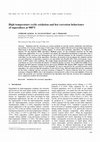
Bulletin of Materials Science, 2010
Oxidation and hot corrosion are serious problems in aircraft, marine, industrial, and land-base g... more Oxidation and hot corrosion are serious problems in aircraft, marine, industrial, and land-base gas turbines. It is because of the usage of wide range of fuels coupled with increased operating temperatures, which leads to the degradation of turbine engines. To obviate these problems, superalloys, viz. Superni 75, Superni 718 and Superfer 800H superalloys (Midhani grade), are the prominent materials for the high temperature applications. It is very essential to investigate the degradation mechanism of superalloys due to oxidation and hot corrosion and substantiate the role of alloying elements for the formation of protective oxide films over the surface of the superalloys. Therefore, the present work investigates the oxidation and hot corrosion behaviour of superalloys exposed to air and molten salt (Na 2 SO 4-60% V 2 O 5) environment, respectively, at 900°C under cyclic conditions. The weight change measurements made on the superalloys during the experiments are used to determine the kinetics of oxidation and hot corrosion. X-ray diffraction (XRD), X-ray mapping and field emission scanning electron microscope (FESEM, FEI, Quanta 200F company) with EDAX Genesis software attachment, made in Czech Republic are used to characterize the corroded products of the superalloys. It is observed that the formation of scale rich in Cr 2 O 3 , NiO and spinel NiCr 2 O 4 has contributed for the better oxidation and hot corrosion resistance of Superni 75; whereas relatively lesser hot corrosion resistance of Superfer 800H is due to the formation of non-protective oxides of iron and sulphides of iron and nickel. The parabolic rate constants calculated for the superalloys show that the corrosion rate is minimum in air as compared to molten salt environment.
Journal of Materials Engineering and …
Rare earth oxide (CeO 2) has been incorporated in NiCrAlY alloy and hot corrosion resistance of d... more Rare earth oxide (CeO 2) has been incorporated in NiCrAlY alloy and hot corrosion resistance of detonation-gun-sprayed NiCrAlY+ 0.4 wt.% CeO 2 coatings on superalloys, namely, superni 75, superni 718, and superfer 800H in molten 40% Na 2 SO 4-60% V 2 O ...

Journal of Alloys and Compounds, 2009
The cyclic oxidation behavior of detonation-gun-sprayed Cr 3 C 2-NiCr coating on three different ... more The cyclic oxidation behavior of detonation-gun-sprayed Cr 3 C 2-NiCr coating on three different superalloys namely Superni 75, Superni 718 and Superfer 800H at 900 • C for 100 cycles in air under cyclic heating and cooling conditions has been investigated in the present work. The kinetics of oxidation of coated and bare superalloys was analysed, using thermogravimetric technique. It was observed that all the coated and bare superalloys obey a parabolic rate law of oxidation. X-ray diffraction, FE-SEM/EDAX and X-ray mapping techniques were used to analyse the oxidation products of coated and bare superalloys. The results on the Cr 3 C 2-NiCr-coated superalloys showed better oxidation resistance due to the formation of a compact and adhesive thin Cr 2 O 3 scale on the surface of the coating during oxidation. The scale remained intact and adherent to the partially oxidised coating during cyclic oxidation due to its good compatibility and similar thermal expansion coefficient between Cr 3 C 2-NiCr coating and the superalloy substrates. In all the coated superalloys, the chromium, iron, silicon and titanium were oxidised in the inter-splat region, whereas splats which consisted mainly of Ni remained unoxidised. The parabolic rate constants of Cr 3 C 2-NiCr-coated alloys were lower than that of the bare superalloys as observed in the present work.
Materials Chemistry and Physics, 2010

ABSTRACT The ZrN films were deposited on type 304L stainless steel using dc magnetron sputtering ... more ABSTRACT The ZrN films were deposited on type 304L stainless steel using dc magnetron sputtering technique at different substrate temperatures from room temperature up to 600°C. The ZrN films have been analysed for their composition, microstructure, surface morphology and their corrosion resistance in different nitric acid concentrations. The grazing incidence angle X-ray diffraction analysis showed the texture orientation of (111) or (200) plane depending on the substrate temperature. The atomic force microscopy analysis reveals the formation of ZrN agglomerates with no visible cracks or pores. However, increase in grain size (10–20 nm) and roughness (10–50 nm) with increase in the substrate temperature was observed. The potentiodynamic polarisation and electrochemical impedance spectroscopy results indicated that the corrosion resistance of different ZrN films, although high in 1 mol L−1 HNO3, suffered a marked decrease in 8 mol L−1 HNO3 concentration.









Uploads
Papers by Dr. subhash kamal